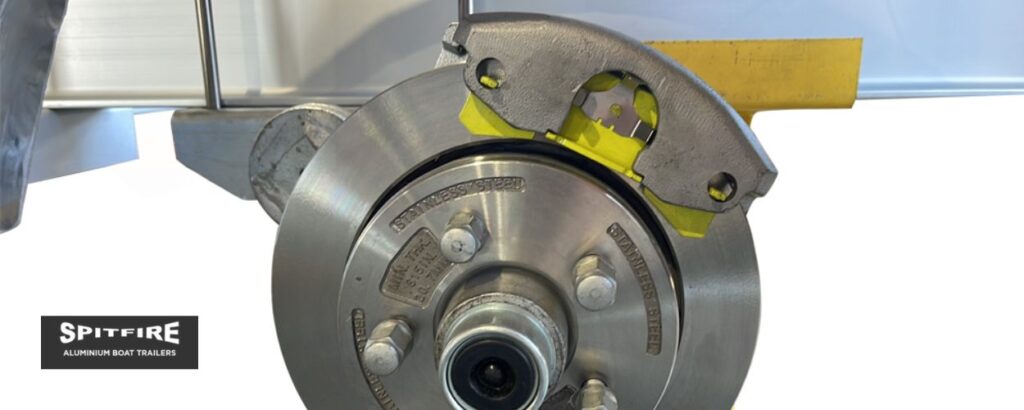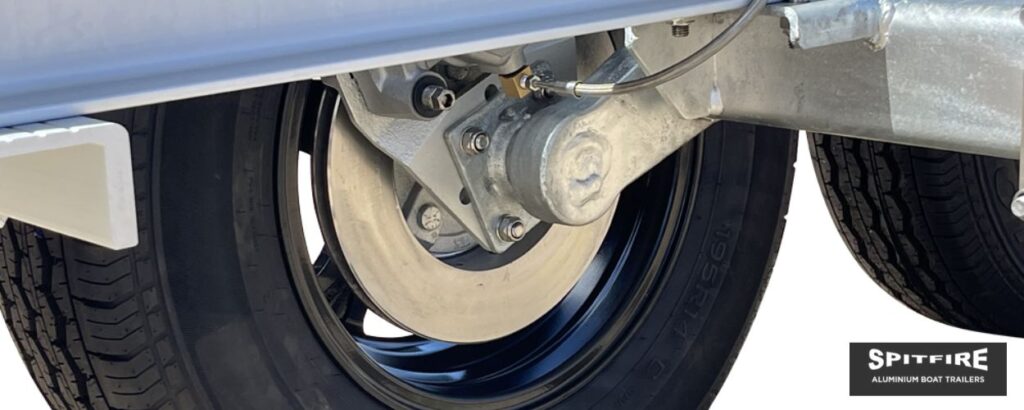Spitfire Boat Trailers
Trailer Brakes: Do You Need Them for Your Boat Trailer?
When towing a boat, safety should always come first. Proper braking systems ensure control, especially when handling heavy loads. Australian regulations mandate specific requirements based on Gross Trailer Mass (GTM). These rules help prevent accidents and protect both drivers and cargo.
For trailers weighing between 750kg and 2000kg, brakes on one axle are compulsory. Loads exceeding 2000kg require braking on all wheels, along with a breakaway system. Ignoring these rules risks fines, insurance complications, and dangerous situations. Imagine trying to stop suddenly with two tonnes pushing from behind—reliable brakes make all the difference.
Spitfire Boat Trailers offers specialised solutions like Deemax Decromat calipers and rotors for durability. Elecbrakes provide smooth, responsive stopping power. Whether legally required or not, quality braking systems enhance safety and peace of mind.
Key Takeaways
- Australian laws require brakes based on trailer weight.
- GTM determines if single or multi-axle braking is needed.
- Spitfire provides high-performance components like Deemax Decromat.
- Non-compliance leads to fines and safety risks.
- Investing in quality systems ensures smoother, safer towing.

Do I Need Brakes on My Boat Trailer? Understanding Australian Laws
Australian road safety laws dictate specific braking requirements for trailers. These rules ensure safe towing, especially when hauling heavy loads. Your trailer’s Gross Trailer Mass (GTM) determines whether braking systems are mandatory and what type you need.
Gross Trailer Mass and Brake Requirements
GTM includes the trailer, boat, and all gear. Calculate it accurately to avoid penalties. Here’s how the regulations break down:
- Under 750kg: No brakes required for single-axle trailers.
- 750kg–2000kg: Brakes on one axle (override mechanical or hydraulic).
- Over 2000kg: Brakes on all wheels plus a breakaway system.
Spitfire Boat Trailers offers solutions like Deemax Decromat components for corrosion resistance. Their Elecbrakes electric systems suit trailers exceeding 2000kg.
Breakaway Systems for Heavy Loads
Trailers over 2000kg need a breakaway system that works for 15 minutes if detached. Spitfire’s designs include backup batteries and durable wiring. A 2021 NSW incident showed how improper GTM calculations caused brake failure, leading to fines.
5-Step GTM Checklist:
- Weigh the empty trailer.
- Add the boat’s weight.
- Include fuel, gear, and accessories.
- Verify against your vehicle’s towing capacity.
- Consult Spitfire for compliant brake upgrades.
Non-compliance risks state fines up to $2,200 and voids insurance. Spitfire guarantees all systems meet Australian standards, with Deemax coatings outperforming standard finishes in saltwater.
Types of Braking Systems for Boat Trailers
Choosing the right braking system ensures safe towing and compliance with Australian regulations. Different setups suit various trailer weights and conditions. Understanding the options helps you make an informed decision.
Override Mechanical and Hydraulic Brakes
Mechanical override systems activate when the tow vehicle slows down. They’re simple and cost-effective for trailers under 2000kg. Hydraulic systems offer smoother operation but require regular fluid checks.
Both types work well for freshwater use. However, saltwater exposure can cause rust in standard components. This is where advanced coatings like Deemax Decromat prove valuable.
Electric Brakes and Controllers
Electric systems, like Spitfire’s Elecbrakes, provide precise stopping power. They use a brake controller to adjust force based on driving conditions. Proportional controllers react instantly, unlike time-delay models.
Key benefits include:
- Better control on steep descents
- Reduced wear on tow vehicle brakes
- Compatibility with heavy loads over 2000kg
Why Spitfire Uses Deemax Decromat Calipers and Rotors
Saltwater accelerates corrosion in standard brake parts. Deemax Decromat coatings withstand 500+ hours in salt spray tests. This technology keeps components functional for years, even in harsh marine environments.
A Moreton Bay case study showed Deemax parts lasting seven years without replacement. Stainless steel hardware and Dacromet finishes prevent rust buildup. This reduces long-term maintenance costs significantly.
System Type | Best For | Maintenance | Saltwater Resistance |
Mechanical Override | Trailers under 2000kg | Low | Moderate (with coatings) |
Hydraulic | Medium loads | Moderate | Good (sealed systems) |
Electric (Elecbrakes) | Heavy loads | Low | Excellent (Deemax coated) |
Proper calibration ensures electric brakes perform optimally. Spitfire provides recommended settings for various trailer weights. A Byron Bay user reported avoiding a jackknife thanks to well-tuned Elecbrakes.

How to Choose the Right Brakes for Your Trailer
Australia’s diverse climates demand tailored solutions for trailer brakes. Whether you’re launching in Darwin’s saltwater harbours or the Murray River’s freshwater, your system must withstand the environment. Spitfire’s advanced materials and configurations ensure reliability, no matter the conditions.
Freshwater vs. Saltwater Considerations
Saltwater accelerates rust, making standard components fail prematurely. For freshwater use, hot-dip galvanised steel offers adequate protection. Weekly saltwater exposure requires Deemax Decromat coatings or stainless steel hardware.
Spitfire’s corrosion resistance comparison:
- Galvanised: Affordable for occasional freshwater use.
- Deemax Decromat: Survives 500+ salt spray hours, ideal for weekly launches.
- Stainless Steel: Best for permanent saltwater moorings.
Matching Brakes to Your Towing Vehicle
Your tow vehicle’s capacity dictates brake type and controller needs. A LandCruiser 300 Series towing 2500kg requires Elecbrakes with proportional control. Smaller vehicles may suit hydraulic systems.
Towing vehicle checklist:
- Verify Gross Vehicle Mass (GVM) limits.
- Ensure brake controller compatibility (time-delay vs. proportional).
- Match axle load ratings to trailer weight.
Spitfire customises systems for unique needs, like Murray River houseboats or Darwin’s tidal launches. Their lifetime cost analysis shows saltwater systems save 40% on replacements over a decade.
Maintaining Your Boat Trailer Brakes for Longevity
Regular upkeep keeps your trailer’s braking system reliable in tough conditions. Saltwater corrosion and heavy loads accelerate wear, but simple steps can prevent damage. Spitfire’s low-maintenance designs, like Deemax-coated components, reduce effort while maximising safety.
Post-Launch Cleaning to Combat Saltwater Damage
Rinsing brakes after saltwater exposure prevents rust buildup. Focus on calipers, rotors, and cables. Use freshwater and a soft brush for Deemax parts—avoid high-pressure sprays that displace protective coatings.
Quick Cleaning Guide:
- Flush components within 24 hours of saltwater contact.
- Inspect for corrosion spots, especially on untreated metal.
- Dry thoroughly to prevent moisture traps.
Routine Checks for Hydraulic and Electric Systems
Hydraulic systems need fluid flushes every two years. Check electric brake wiring monthly for fraying. Spitfire’s Elecbrakes include self-diagnostic sensors, but manual inspections catch early issues.
Task | Frequency | Tools Needed |
Brake pad inspection | Monthly | Torch, caliper gauge |
Hydraulic fluid change | Biannually | DOT 4 fluid, bleed kit |
Electric brake calibration | Seasonally | Controller manual, multimeter |
Common Issues & Fixes:
- Sticking brakes: Clean and lubricate slide pins.
- Uneven wear: Adjust caliper alignment.
- Warning lights: Test Elecbrakes’ sensor connections.
Neglect can be costly—a Gold Coast owner faced a $2,300 repair after skipping washes. Spitfire’s 5-year warranty stays valid with logged maintenance. Their kits include corrosion-resistant grease and Dacromet touch-up paint.
Conclusion: Prioritising Safety with the Right Braking System
Investing in quality braking systems goes beyond legal requirements—it’s about protecting lives. With 73% of trailer accidents linked to brake failures, compliance alone isn’t enough. Spitfire’s Deemax-coated components and Elecbrakes deliver unmatched durability, especially in harsh marine conditions.
Australian regulations set clear thresholds: 750kg triggers single-axle brakes, while a 2000kg boat trailers and above, demands full systems. Spitfire’s solutions exceed these benchmarks, backed by 450+ five-star reviews. Their corrosion-resistant designs slash long-term costs and prevent roadside emergencies.
Don’t gamble with safety. Choose a Spitfire Boat Trailer. Our innovations promise even smarter towing protection. Contact us today to get started.
FAQ
Q: What determines if my boat trailer requires brakes?
A: Australian regulations require braking systems if your trailer’s Gross Trailer Mass (GTM) exceeds 750kg. Trailers over 2000kg must also have a breakaway system for safety.
Q: What are the main types of braking systems for trailers?
A: Common options include override mechanical or hydraulic brakes, electric brakes with controllers (like Spitfire’s Elecbrakes), and drum or disc setups. The best choice depends on your towing setup and conditions.
Q: How do I choose the right brakes for freshwater vs. saltwater use?
A: Saltwater demands corrosion-resistant materials like stainless steel or galvanised components. Freshwater setups can use standard materials but still benefit from protective coatings.
Q: Should my trailer brakes match my towing vehicle?
A: Yes. Electric brakes require a compatible controller in your vehicle, while hydraulic systems need proper weight distribution. Always check your vehicle’s towing capacity and compatibility.
Q: How often should I maintain my trailer brakes?
A: Clean brakes after every saltwater launch and inspect them monthly. Check hydraulic lines for leaks and test electric connections for wear or corrosion.
Q: What’s the benefit of a breakaway system?
A: If your trailer detaches while moving, this system automatically engages the brakes, preventing uncontrolled movement. It’s legally required for trailers over 2000kg in Australia.

